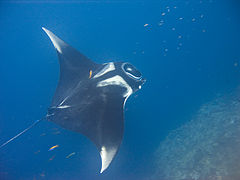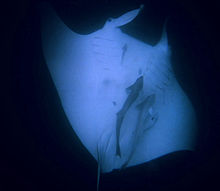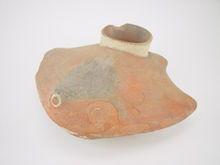- Manta ray
-
This article is about the animal. For things named after it, see Manta (disambiguation) and Devil ray (disambiguation).
Manta ray
Temporal range: 23–0 Ma[1] Early Miocene to Present
Manta ray at Hin Daeng, Thailand Conservation status Scientific classification Kingdom: Animalia Phylum: Chordata Class: Chondrichthyes Subclass: Elasmobranchii Order: Myliobatiformes Family: Myliobatidae Genus: Manta
Bancroft, 1829Species: M. birostris Binomial name Manta birostris
(Walbaum, 1792)The manta ray (Manta birostris) is the largest species of the rays. The largest known specimen was more than 7.6 metres (25 ft) across, with a weight of about 1,300 kilograms (2,900 lb). It ranges throughout waters of the world, typically around coral reefs. They have the largest brain-to-body ratio of the sharks, rays and skates (Elasmobranchii),[2] a brain which is kept warm during lengthy dives to as deep as 500 metres in cold water.
Mantas have a variety of common names, including Atlantic manta, Pacific manta, devilfish, and just manta. At one time it was thought that there were many species of manta. Until quite recently, scientific consensus has been that there is just one species,[3] a view supported by mitochondrial DNA studies.[4]
However recent studies have suggested that manta rays actually comprise at least two different species, the giant manta (Manta birostris), which migrates, and another smaller one called the reef manta (Manta alfredi), which does not.[5][6][7] The use of the "alfredi" name is questionable. The species alfredi was first used in the description of Prince Alfred's manta ray by Krefft in 1868.[8] [9] Modern genetic studies have shown that Ceratoptera alfredi (Krefft, 1868), revised as Manta alfredi (Krefft, 1868), is a synonym of Manta birostris (Donndorff, 1798). The genus is generally considered to be in need of worldwide revision. Even the accepted name Manta birostris is often incorrectly ascribed to Walbaum (1792).
Video of a manta ray
Contents
Etymology
The term manta derives from the Spanish word manta, meaning cloak or blanket. This term originated from a type of trap traditionally used to catch rays that has a form resembling a blanket.[10]
Taxonomy
Manta rays can be not only bottom-feeders, but can adapt to the open ocean by filter feeding. This feeding strategy allowed them to grow larger than other ray species. Some ancestral characteristics degenerated due to the feeding change. For example, all that remains of the oral teeth is a small band of vestigial teeth on the lower jaw, almost hidden by the skin. The number and size of their dermal denticles are also reduced. Manta rays have a much thicker mucus body coating than other rays. Their spiracles have become small and non-functional, as all water is consumed orally. Mantas have a tail similar to stingrays, but they have lost their stinger and are harmless to divers.[11]
Description
Manta rays have a distinctive body shape with triangular pectoral ‘wings’ and paddle-like lobes extending in front of their mouths. The disc width is up to 6.7 metres and the weight up to 1400 kilograms. They are generally dark on the upper surface, ranging from black to greyish-blue and brown, with pale undersides; individuals have a unique pattern of blotches and scars that can be used to identify them. The large, cavernous mouth is situated at the front of the body and contains 18 rows of teeth on the lower jaw.[12]
Biology
Mantas feed on plankton, fish larvae and the like, filtered from the water passing through their mouths and out of their gills as they swim. They catch small prey organisms on gill rakers, flat plates of russet-colored spongy tissue spanning spaces between the manta's gill bars. An average-sized manta is estimated to take in 20-30kgs of plankton per day. Individuals have been observed swimming in slow vertical loops whilst feeding, possibly in an effort to concentrate prey items. The fleshy projections on either side of the mouth are also used to funnel prey; when not feeding, these lobes are either furled or closed in front of the mouth. Manta rays are often host to remoras (Remorina spp.), which attach to the underside of the larger fish and consume particles of food that fall from the mouth. They are exceptionally graceful swimmers and appear to fly through the water on their large wings. Individuals have also been observed to jump clear out of the water, possibly in a form of communication or play.[12]
The breeding behaviour observed for manta rays is similar to other closely related rays. Copulation occurs near the surface, no deeper than a metre below. It begins with the male chasing the female, for up to half an hour, both often closely followed by a train of hopeful suitors. Such mating trains seem to be triggered by a full moon. The male bites the pectoral fin and then moves its claspers into the cloaca, holding it there for a minute to a minute and a half while copulation takes place.[13] The developing eggs remain inside the female’s body for possibly as long as 12 months and hatch internally so that she gives birth to live young. The average litter size is two pups, and there is often a two year gap between births.[14]
Behaviour
Manta rays frequently visit cleaning stations where small fish such as wrasse, remora, and angelfish swim in the manta's gills and over its skin to feed, in the process cleaning it of parasites and dead tissue. Like other species in the shark family they must swim to keep from sinking, so that their stay at a cleaning station is characterised by slow circuits.
Large sharks and in some circumstances orcas, are the manta's main predators.[15]
Mantas sometimes breach the surface and launch themselves into the air.
The Maldives are a hotspot for plankton and consequently for reef mantas. A population of 6-7 000 is resident throughout the year. Here they frequently feed by skimming the surface, but when plankton concentrations are particularly high, hundreds of rays will assemble and form a feeding vortex, sometimes in the company of whale sharks.
In captivity
Manta rays are very rarely kept in captivity, primarily due to their size. Only four aquariums in the world display manta rays.[16] One notable example is "Nandi", a manta ray that was accidentally caught in shark nets off Durban, South Africa in 2007. Rehabilitated, and outgrowing her aquarium, uShaka Marine World, Nandi moved to the larger Georgia Aquarium in August 2008, where she resides in its 6.2-million-gallon "Ocean Voyager" exhibit. A second manta ray joined that aquarium's collection in September 2009, dubbed "Tallulah." A third manta ray has recently been added to the Ocean Voyager exhibit.[17]
The Okinawa Churaumi Aquarium also houses manta rays in the "Kuroshio Sea" tank, the second-largest aquarium tank in the world. On June 16, 2007, the first manta ray born in captivity was born at the aquarium. Although the pup born in 2007 did not survive, the aquarium has also since seen the birth of two more manta rays in 2008 and 2009.[18]
The Lisbon Oceanarium also hosted a manta ray, Manta birostris, from 2002 until releasing it in 2007. A devil ray, Mobula mobular, was introduced in 2003 and lives there still.
Threats
Human influences such as fishing and use in Chinese medicines are severe threats to the manta ray population. Taking roughly 12 months for a female manta ray to give birth to a single pup it is no surprise that these creatures are extremely vulnerable to overfishing.
In culture
The ancient Peruvian Moche people worshipped the sea and its animals. Their art often depicts manta rays.[19] Not knowing about their gentle nature, two 1930s movies played on the manta's "fearsome" appearance: 1930's The Sea Bat, starring a pre-Frankenstein Boris Karloff, and 1936's The Sea Fiend, later re-issued as the 1946 Devil Monster.
In 2009, SeaWorld Orlando debuted Manta, a flying roller coaster themed to resemble the manta ray, along with an exhibit featuring other ray species. A similar attraction will debut at SeaWorld San Diego in 2012.
The original Opel Manta A sports coupe build in the 70s in Germany derives its name from its distinctive front section that is designed to imitate the shape of the Manta rays "face".
The American alternative rock band Pixies has also recorded songs called "Manta Ray" and "Dancing the Manta Ray." In 2010, the alternative band Ludo released a song titled "Manta Rays."[20]
The Manta Ray is one of the animals available in the Marine Mania expansion pack of Zoo Tycoon and its sequel Zoo Tycoon 2.
Gallery
-
Close-up of manta at Manta Point in Bali
See also
References
This article incorporates text from the ARKive fact-file "Manta ray" under the Creative Commons Attribution-ShareAlike 3.0 Unported License and the GFDL.
- ^ Sepkoski, Jack (2002). "A compendium of fossil marine animal genera (Chondrichthyes entry)". Bulletins of American Paleontology 364: 560. http://strata.ummp.lsa.umich.edu/jack/showgenera.php?taxon=575&rank=class. Retrieved 2008-01-09.
- ^ "Manta Rays". The Hawaii Association for Marine Education and Research, Inc.. 2005. http://www.hamerinhawaii.org/Main%20Web%20Pages/Education/Marine%20Life/Rays/manta_rays.htm. Retrieved 2007-12-09.
- ^ Last, P.R.; Stevens, J.D. (1994). Sharks and rays of Australia. Melbourne, Australia: CSIRO. ISBN 0643051430.
- ^ Clark, Timothy Brian (2002). Population Structure of Manta birostris (Chondrichthyes: mobulidae) from the Pacific and Atlantic Oceans (MS thesis). Texas A & M University. OCLC 52083914.
- ^ "Manta Rays: A new species?". Save Our Seas Foundation. http://www.saveourseas.com/manta-rays-a-new-species.
- ^ http://www.bbc.co.uk/nature/species/Manta_ray#p0052vwz
- ^ "Manta Ray Research". Foundation for the Protection of Marine Megafauna. http://marinemegafauna.org/mantarays/. Retrieved 2010-05-12.
- ^ "Manta". Florida Museum of Natural History. http://www.flmnh.ufl.edu/fish/gallery/Descript/MantaRay/MantaRay.html. Retrieved 2009-11-11.
- ^ Whitley GP (1936). "The Australian devil ray, Daemomanta alfredi (Krefft), with remarks on the superfamily Mobuloidea (order Batoidei)". Australian Zoologist 8 (3): 164–188.
- ^ "manta". Collins English Dictionary - Complete & Unabridged (via Dictionary.com) (HarperCollins Publishers). http://dictionary.reference.com/browse/manta.
- ^ Manta Ray (Manta birostris) FAQ
- ^ a b Biological profiles: Manta birostris Florida Museum of Natural History. Retrieved 2011-08-24.
- ^ Yano, Kazunari; Sato, Fumihiko; Takahashi, Tomoko (September 1999). "Observations of mating behavior of the manta ray, Manta birostris, at the Ogasawara Islands, Japan". Ichthyological Research 46 (3): 289–96. doi:10.1007/BF02678515.
- ^ Biology of the Manta Ray (Manta birostris) Biology of Sharks and Rays. Retrieved 2011-08-24.
- ^ "Pacific Manta Ray". theBIGzoo. 2010. http://www.thebigzoo.com/Animals/Pacific_Manta_Ray.asp. Retrieved 2009-12-27.
- ^ "About Nandi". Georgia Aquarium. http://www.georgiaaquarium.org/nandi/about-nandi/. Retrieved 2008-08-27.
- ^ Andres, Bob (2009-09-03). "Second manta ray at Georgia Aquarium". The Atlanta Journal-Constitution: p. A1.
- ^ "3 Years in a row!". Okinawa Churaumi Aquarium. http://www.kaiyouhaku.com/en/news/09092801_01_info.html. Retrieved 2009-12-12.[dead link]
- ^ Berrinjk, Katherine (1997). The Spirit of Ancient Peru:Treasures from the Museo Arqueológico Rafael Larco Herrera. New York: Thames and Hudson.
- ^ "Ludo: Album: Prepare the Preparation". Island Def Jam Music Group. http://www.ludorock.com/discography/detail.aspx?pid=12336. Retrieved 2009-11-11.
External links
Categories:- IUCN Red List vulnerable species
- Myliobatidae
- Fish of Hawaii
- Monotypic fish genera
- Animals described in 1934
- Fish of Malaysia
Wikimedia Foundation. 2010.






